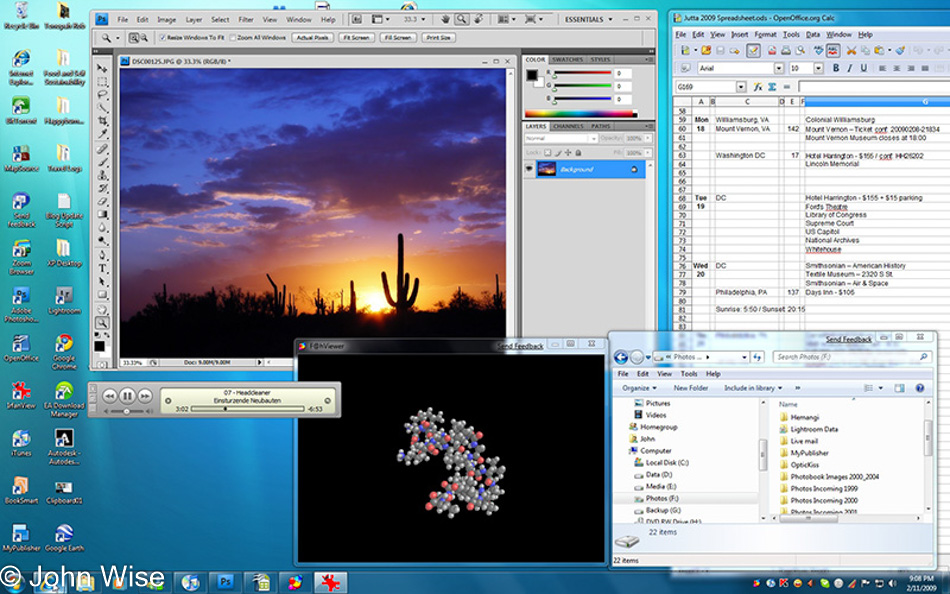
On January 27 I bought the components to build myself a new computer. What motivated this was the rave reviews I was reading regarding Microsoft’s beta release of Windows 7. As a lot of what I do with a PC revolves around photography, moving to a 64-bit operating system that would allow me to go beyond 4GB of RAM was appealing, upgrading to the 64-bit version of Photoshop and Lightroom also held sway. I started with downloading the Windows 7 beta and then began my search for what it would cost to build a new computer. One of my hopes was to upgrade to a solid-state drive if I could afford it. Turns out the prices for components in comparison to what they are delivering are fantastically low right now.
Not long after lunch I was on my way to Fry’s Electronics to buy a new motherboard, an Intel 3.16Ghz Core2Duo CPU ($189), 8GB of DDR3 PC1600 RAM ($240), a 1.5TB hard drive ($129), an NVidia 9600GT video card with 512MB DDR3 RAM ($99), a 650W power supply, a new case, and a 64GB solid-state drive from Patriot. The rest of the parts would come from my old computer. What really amazed me about today’s purchase more than in previous years was the exponential difference of this computer to the ones I was building in the early to mid-’90s. For example: in 1993, my 486DX-66 cost about $400 for the CPU alone and packed 1.2 million transistors. The E8500 from Intel on the other hand has about 410 million transistors, is approximately 648 times faster than the 486, and cost me $189. Six hundred forty-eight CPUs running on 648 motherboards 16 years ago would have cost about $2 million.
But that’s not all. I bought 8GB of RAM. Back in the day, I had three PCs for rendering and modeling 3D images, each had 64MB of RAM – the maximum. I will never forget that we paid $100 a megabyte. If memory were still to cost that much, I had just purchased $800,000 of RAM. This new PC will inherit two of the 500GB hard drives plus the new 1.5TB drive and the 64GB SSD (solid-state drive). This amount of storage capacity would have cost $2,564,000 in 1993. I’ve tried to price a video performance comparison but this has proven too difficult. I’ll leave this with that today’s expenditure of $1200 would have cost approximately $5.6 million in the mid-’90s.
Windows 7 – wow. This operating system has been performing flawlessly, so much so that I took my old PC, added a new video card, a new solid-state drive, a 1.5TB drive, and installed Windows 7 on it for Caroline. For a beta o/s, this is amazing. I had tried Vista for a short while before going back to XP feeling Microsoft blew it and maybe had lost its touch – it has not. The only thing not working for me is my old discontinued Garmin GPS, not a deal-breaker. There have been some minor glitches getting the networking to function properly but forums and trial and error have ironed those speed bumps out. The performance is astounding, the load time for Windows 7 from the solid-state drive is well under a minute, and that’s with Yahoo and MSN Messenger loading along with Kaspersky Anti-Virus, Southwest Air’s Ding, Skype, and EA Download Manager. Once the o/s is up and ready, opening Photoshop CS4 64-bit takes less than 5 seconds. iTunes with 4678 songs opens in about 4 seconds. OpenOffice needs maybe 3 seconds to launch and be ready to type. Finally, Lightroom opens and is ready in about 20 seconds, mind you, it is managing more than 200GB of photos, that’s about 70,000 digital photos.
There are some great new features in Windows 7 and IE8, together they bring some of the fun back to my computer – it has been a long time since I felt so enthusiastic about spending time on this box that in its own right is a bit of a miracle. I can’t wait for the next release from Microsoft.